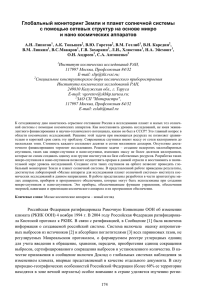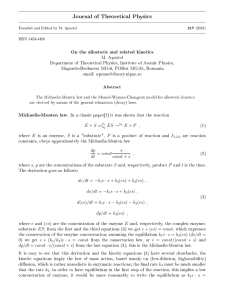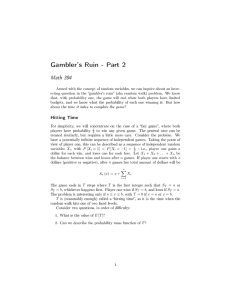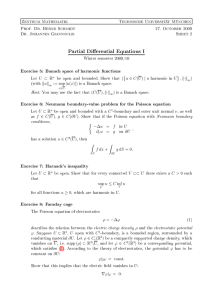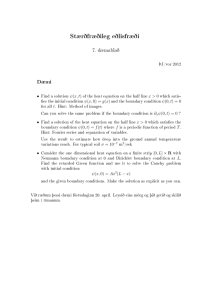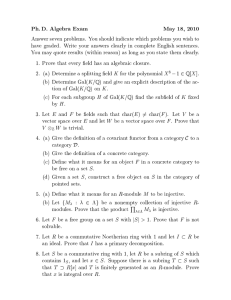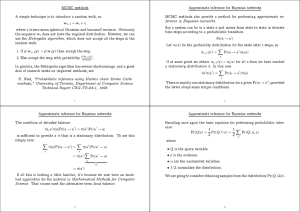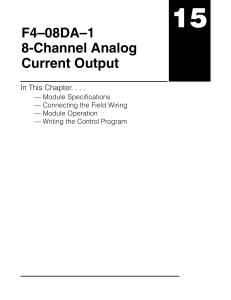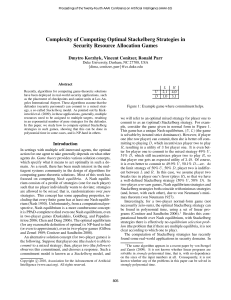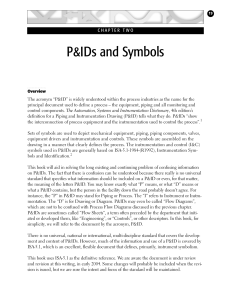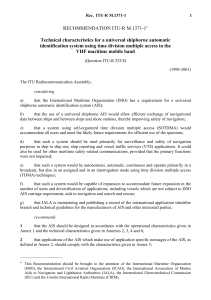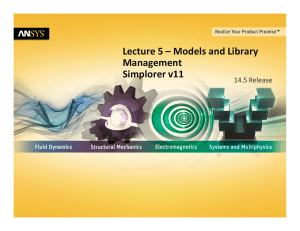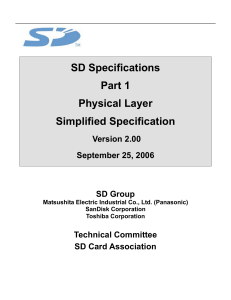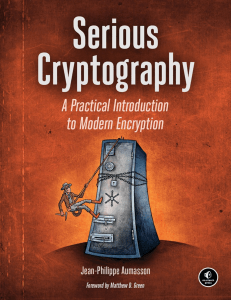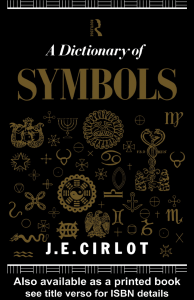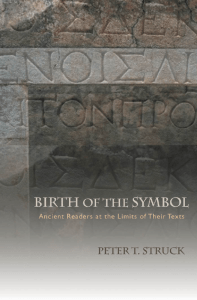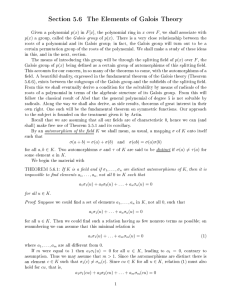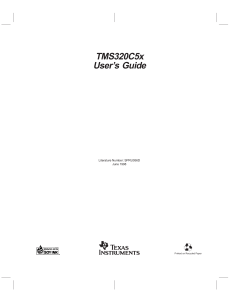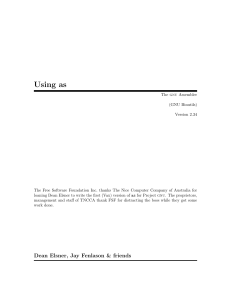сы шсып п ьс р с
advertisement
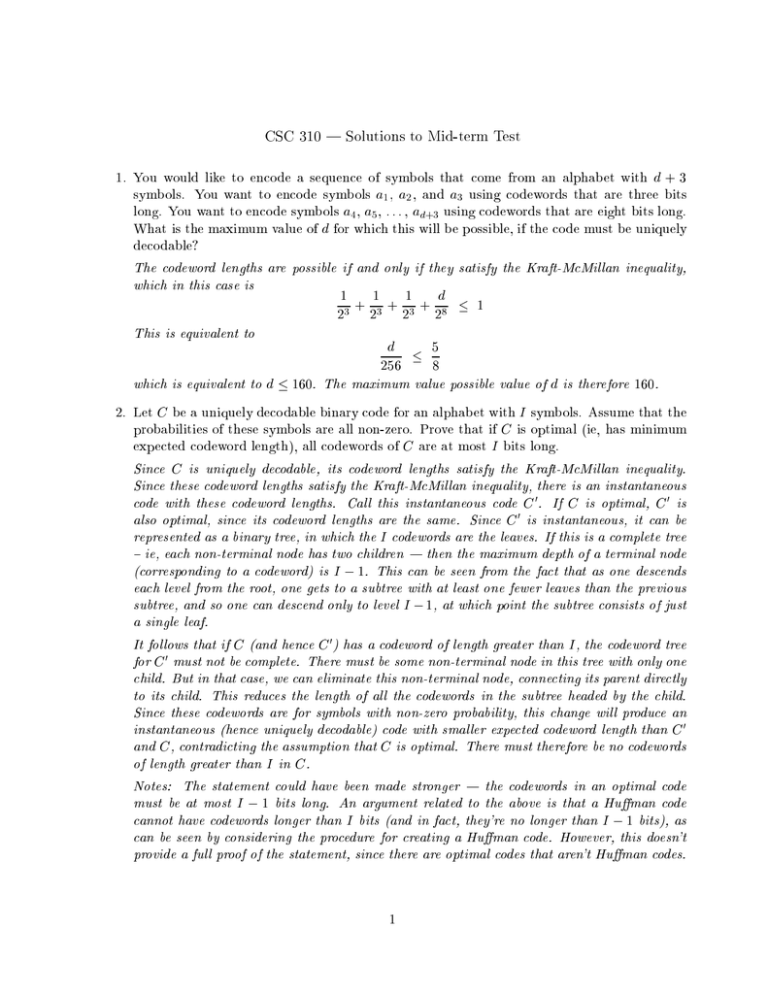
CSC 310 | Solutions to Mid-term Test
1. You would like to enode a sequene of symbols that ome from an alphabet with d + 3
symbols. You want to enode symbols a1 , a2 , and a3 using odewords that are three bits
long. You want to enode symbols a4 , a5 , . . . , ad+3 using odewords that are eight bits long.
What is the maximum value of d for whih this will be possible, if the ode must be uniquely
deodable?
The odeword lengths are possible if and only if they satisfy the Kraft-MMillan inequality,
whih in this ase is
This is equivalent to
1
1
d
1
+ 3+ 3+ 8
3
2
2
2
2
d
256
1
5
8
whih is equivalent to d 160. The maximum value possible value of d is therefore 160.
2. Let C be a uniquely deodable binary ode for an alphabet with I symbols. Assume that the
probabilities of these symbols are all non-zero. Prove that if C is optimal (ie, has minimum
expeted odeword length), all odewords of C are at most I bits long.
Sine C is uniquely deodable, its odeword lengths satisfy the Kraft-MMillan inequality.
Sine these odeword lengths satisfy the Kraft-MMillan inequality, there is an instantaneous
ode with these odeword lengths. Call this instantaneous ode C 0 . If C is optimal, C 0 is
also optimal, sine its odeword lengths are the same. Sine C 0 is instantaneous, it an be
represented as a binary tree, in whih the I odewords are the leaves. If this is a omplete tree
{ ie, eah non-terminal node has two hildren | then the maximum depth of a terminal node
(orresponding to a odeword) is I 1. This an be seen from the fat that as one desends
eah level from the root, one gets to a subtree with at least one fewer leaves than the previous
subtree, and so one an desend only to level I 1, at whih point the subtree onsists of just
a single leaf.
It follows that if C (and hene C 0) has a odeword of length greater than I , the odeword tree
for C 0 must not be omplete. There must be some non-terminal node in this tree with only one
hild. But in that ase, we an eliminate this non-terminal node, onneting its parent diretly
to its hild. This redues the length of all the odewords in the subtree headed by the hild.
Sine these odewords are for symbols with non-zero probability, this hange will produe an
instantaneous (hene uniquely deodable) ode with smaller expeted odeword length than C 0
and C , ontraditing the assumption that C is optimal. There must therefore be no odewords
of length greater than I in C .
Notes: The statement ould have been made stronger | the odewords in an optimal ode
must be at most I 1 bits long. An argument related to the above is that a Human ode
annot have odewords longer than I bits (and in fat, they're no longer than I 1 bits), as
an be seen by onsidering the proedure for reating a Human ode. However, this doesn't
provide a full proof of the statement, sine there are optimal odes that aren't Human odes.
1
3. Find a binary Human ode for the soure alphabet fa1 ; a2 ; a3 ; a4 ; a5 g, with symbol probabilities p1 = 0:11, p2 = 0:05, p3 = 0:10, p4 = 0:70, and p5 = 0:04. Show this ode as a table
giving the odeword for every soure symbol. Show your work.
In the Human algorithm, we will merge symbols a2 and a5 , then a3 and this merged symbol,
then a1 and the last merged symbol, and nally a4 and the last merged symbol. Various odes
an result from this, depending on how branhes are labelled with 0 and 1. One possible result
is as follows:
a1 :
10
a2 :
1110
a3 :
110
a4 :
0
a5 :
1111
4. This question onerns arithmeti oding for a binary soure alphabet in whih the symbol
probabilities are p0 = 1=3 and p1 = 2=3. Assume the arithmeti enoder operates as desribed
in the letures, with the oding interval (initially [0; 1)) shrinking as eah symbol is enoded,
bits then being output if they are determined, and the oding interval being expanded as bits
are output, or when it is entirely in the middle of the oding range. Fill in the table below
to show how this proedure operates as the symbols 1, 1, and 0 are enoded. Assume that
symbol 0 is alloated the low part of the oding region (nearer 0).
Input
symbol
Interval after
shrinking for
this symbol
Bits output
at this point
(if any)
Interval after
expansion
1
[1/3, 1)
none
[1/3, 1)
1
[5/9, 1)
1
[1/9, 1)
0
[1/9, 11/27)
0
[2/9, 22/27)
2
5. Suppose we are ompressing a soure of symbols from a binary alphabet, f0; 1g, using arithmeti oding. We model the very rst symbol by saying that 0 and 1 are equally likely. For
the seond and later symbols, we will use probabilities from a rst-order Markov model.
For the two questions below, onsider the following sequene of symbols to be ompressed:
1 1 1 1 0
a) Suppose that both the enoder and the deoder x the probabilities of transitions in the
Markov hain as follows:
( = 1 j Xn
P (Xn = 1 j Xn
P (Xn = 0 j Xn
P (Xn = 0 j Xn
P Xn
1 = 0)
1 = 1)
1 = 0)
1 = 1)
=
=
=
=
1=4
7=8
3=4
1=8
Approximately how many bits will the arithmeti oder output when ompressing this
sequene? You may write an arithmeti expression for this rather than an atual number.
The Shannon information ontent of the sequene is minus the log of its probability,
whih is found by multiplying the probabilities of eah symbol given the previous symbols:
log2
1 7 7 7 1
2 8 8 8 8
= 4:5779 bits
Arithmeti oding will produe approximately this many bits as output. More speially,
it will produe no more than this number of bits plus two, so it will output at most 6 bits.
b) Suppose instead that the enoder and deoder don't know the probabilities for transitions, but estimate them adaptively using the Laplae sheme (adding one to the
observed ounts).
Approximately how many bits will the arithmeti oder output when ompressing this
sequene? You may write an arithmeti expression for this rather than an atual number.
The Shannon information ontent is now found using the adaptively estimate probabilities. The result is:
1 1 2 3 1
log2 2 2 3 4 5
= 5:322 bits
Arithmeti oding will produe approximately this many bits as output, and no more than
this number of bits plus two. So it will output at most 7 bits.
Note: Here I've assumed that we ount only atual transitions, so that when the seond
`1' is enoded, there have been no transitions before. If you assumed that the rst `1'
follows an imaginary `0' or an imaginary `1', you would get a dierent answer.
3
